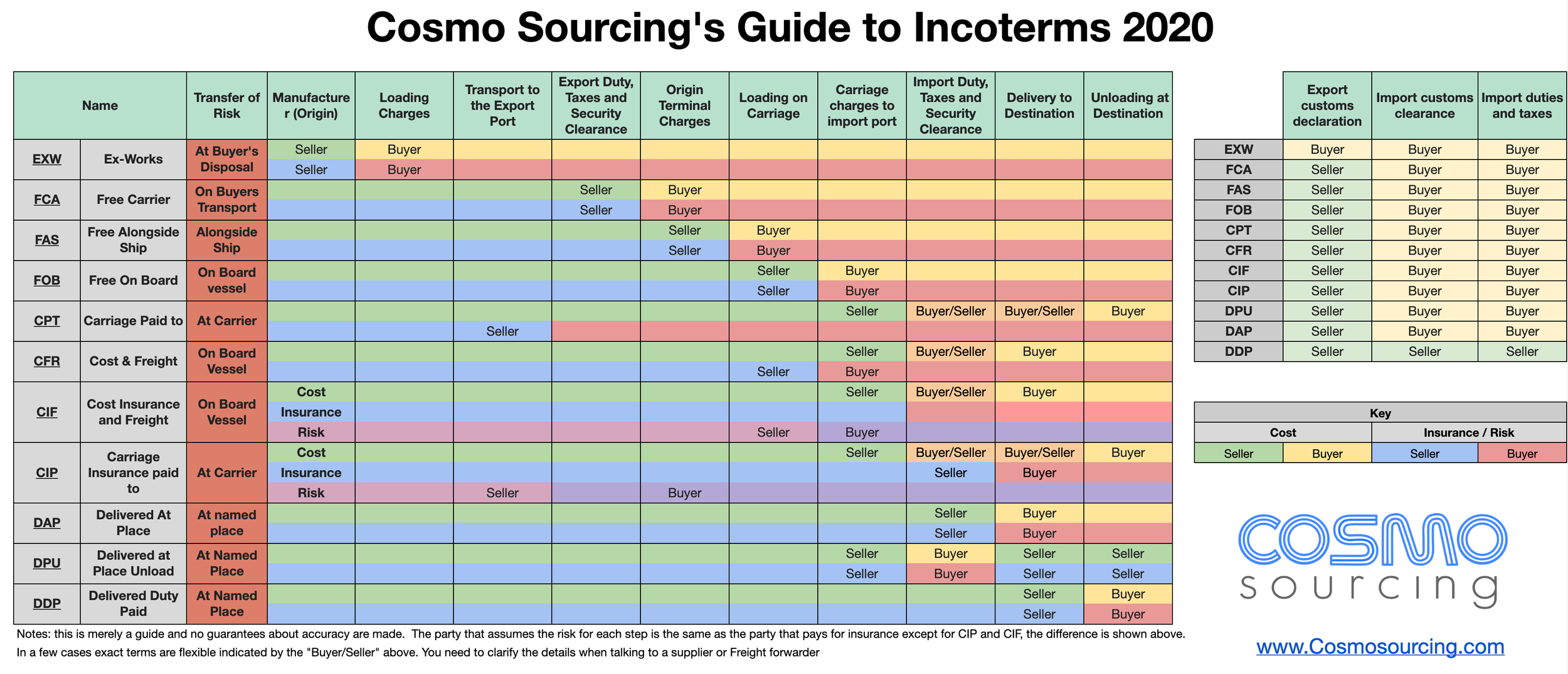Incoterms 2020 vs 2010 // Changes Between The 2020 Incoterms and the 2010 Incoterms
Incoterms are established by the International Chamber of Commerce (ICC) to specify when and how a shipment will be transferred between a buyer and a supplier. The ICC updated the terms into what is known as Incoterms 2020. Incoterms also define who is expected to pay the insurance and when the risk transfer happens between the buyer and the seller. This is the first time that the Incoterms drafting group has included representatives from China.
Navigating the complex waters of international trade requires a thorough understanding of the rules and terms governing global commerce. A critical aspect of this understanding lies in knowing the Incoterms, or International Commercial Terms, standardized trade terms used worldwide. These terms are periodically updated to reflect the changing dynamics of international trade, and significant updates were made in both 2010 and 2020. Understanding the differences between the Incoterms 2010 and 2020 is essential for anyone involved in global trade, as these changes can profoundly impact contracts, logistics, and overall trade strategies.
This blog post will delve into the nuances that distinguish the 2010 version of Incoterms from its 2020 successor. The introduction of new terms, the modification of existing ones, and the shifts in liability and cost implications are more than just minor adjustments; they represent the evolving landscape of international trade, influenced by technological advancements, changes in trade practices, and the need for clearer communication in transactions.
Whether you are a seasoned exporter, an importer, a logistics professional, or someone new to the field of international trade, this exploration will provide you with a clearer understanding of how these changes affect your business operations. We will break down the technical jargon into understandable concepts, highlight key changes, and explain the practical implications of these updates.
Join us as we journey through the intricacies of the 2010 and 2020 Incoterms, equipping you with the knowledge to navigate the legalities and logistics of international trade with confidence and expertise.
Click Here to get a shareable image of the 2020 Incoterms
This article will only cover the updates and assumes you are already familiar with the Incoterms.
On January 1, 2020, the new Incoterms 2020 went into effect. These new terms were released by the International Chamber of Commerce in Sept of 2019 and set guidelines for handling shipments between sellers and buyers in different countries. The ICC has released new Incoterms every decade, with the last change in 2010. Incoterms also define who is expected to pay the insurance and when the risk transfer happens between the buyer and the seller. However, this is the first time that the Incoterms drafting group has included representatives from China.
One key point to remember is that the Incoterms are voluntary and must be explicitly included in the contract. Incoterms are defined and recognized globally, so it is essential to reference them when drafting a contract. Regardless, you can choose not to use the Incoterms when creating a shipping contract if you define which parties are responsible for delivering goods, insurance, shipment, risk, customs clearance, etc.
What Distinguishes the 2010 and 2020 Incoterms?
Overall, the differences between the 2010 and 2020 Incoterms are relatively minor compared to the changes of previous decades. There is only one new term, and most changes are minor.
DAT is now DPU
DPU (Delivery Place Unloaded) replaces DAT (Delivery at Terminal) in the Incoterms 2020. This is the only newly named term in the guide, which is the same but has more explicit language and rules. The obligations of the Buyer and Seller are the same in both DP and DAT.
The ICC viewed the change as necessary, as goods cannot be unloaded at the dock, port, or airport. Therefore, they needed to clarify that goods could only be unloaded after they had been cleared by customs and arrived at a final destination, such as a warehouse.
FCA option for On-Board notation for Bill of Lading
In the Incoterms 2010 rules, the responsibility for the On Board Bill of Lading was not defined and had to be clarified in the contract if the FCA option was chosen. As this leads to confusion, the new 2020 rules clarify that the buyer should instruct the carrier or its agent to release the Bill of Lading(B/L) on the seller’s behalf. The bill of lading (B/L) will have an annotation stating that the goods have been loaded onto the vessel. The Bill of Lading is one of the most common documents used to release payment when paying by letter of credit.
New Insurance Rules For CIF and CIP
There are changes to the Cost, Insurance, and Freight (CIF) and Carriage and Insurance Paid to (CIP) Incoterms, which are the only Incoterms that define who is responsible for paying insurance. For both CIF and CIP, the seller is responsible for paying the insurance. Previously, the seller was only responsible for meeting the minimum insurance requirements; however, under the new rules, the seller must purchase insurance for the shipment to at least 110% of the goods' value.
Greater clarity on who is responsible for what
The new 2020 clarified which party, the buyer or seller, is responsible for Customs Clearance, which party is responsible for the payments, and who will assume the risk and insurance cost. The new rules were rewritten to use less technical jargon and to be more easily understood. It attempted to make the rules as clear as possible while still ensuring they were legally enforceable in a multinational legal contract.
DIY Transport Options
For the first time, the new Incoterms recognize that buyers and sellers can transport the goods using their vehicles. In the previous version, the rules assumed that a third-party shipping service would exclusively handle the transportation. This means they recognize buyers can now pick up goods using their vehicle from a port or terminal destination.
This update only affects Free Carrier (FCA), Delivered at Place (DAP), Delivered at Place Unloaded (DPU), and Delivered Duty Paid (DDP)
New Security Requirements
The new rules clarify which party is liable at two key points: Transport from the country of origin and customs clearance into the destination country.
For transportation out of the country, the seller is liable for CPT, CFR, CIP, CIF, DAP, DPU, and DDP, while the buyer is liable for EXW, FCA, FAS, and FOB. Customs clearance falls on the party defined in the terms.
Sourcing Kit: Take Control of Your Sourcing!
Are you ready to take control of your sourcing process and confidently navigate Incoterms? Sign up for the Sourcing Kit today and gain access to an array of invaluable resources designed to streamline your sourcing journey. Our comprehensive toolkit includes detailed contract templates, step-by-step self-guided courses, practical scripts, and more.
Don’t let the complexities of global sourcing hold you back. Empower yourself with the knowledge and tools you need for a seamless, successful sourcing experience. Click here to start with the Sourcing Kit and transform your connections with top manufacturers in China and Vietnam. Your path to sourcing excellence begins today!

